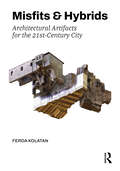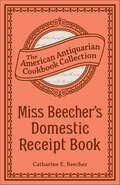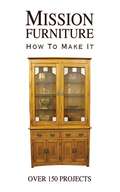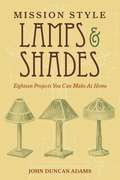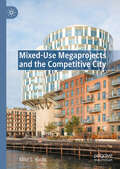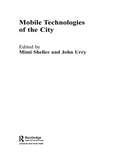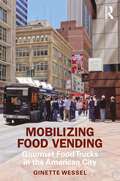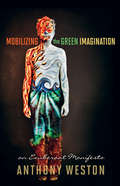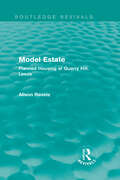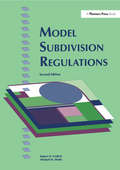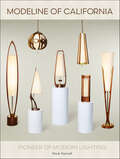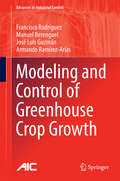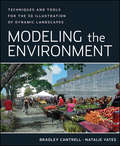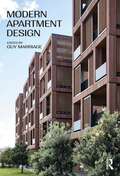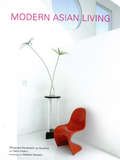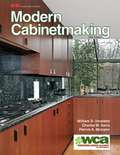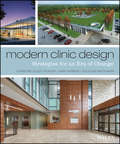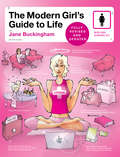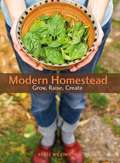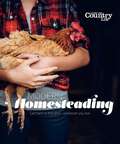- Table View
- List View
Misfits & Hybrids: Architectural Artifacts for the 21st-Century City
by Ferda KolatanContemporary cities are shaped by the unlikely adjacencies of objects that are vastly different in kind, origin, and scale: buildings, infrastructure, and other urban components that over time accumulate into mismatched configurations. However, despite the ubiquity of these oddities and their impact on the city, we rarely give them much consideration. In Misfits & Hybrids, Ferda Kolatan explores the untapped potential in these unexpected conditions for a new kind of architecture. A diverse array of projects, developed in Kolatan’s design studios at the University of Pennsylvania Weitzman School of Design, illustrates how hybrid artifacts can reveal the often overlooked cultural, socio-political, and material histories of a site, fostering design tactics invested in reinventing the existing. Set within the cosmopolitan megacities of Istanbul, Cairo, and New York, the projects are conceived as real fictions, conjuring novel narrative, aesthetic, and representational forms to reflect the pluralistic postindustrial city.
Miss Beecher's Domestic Receipt Book: Designed As a Supplement to Her Treatise on Domestic Economy
by Catharine BeecherPublished in 1846 in New York, Miss Beecher&’s Domestic Receipt Book was written by Catharine Esther Beecher, one of the most influential women writers and social activists of her time. This best-selling cookbook had over 25 printings, and it included detailed recipes that were created to make life easier and improved for the average housewife, simultaneously celebrating women&’s work as an art form. The &“original&” recipes have all been tested by respected housewives and include directions for royal crumpets, sassafras jelly, rice griddle cakes, codfish relish, mutton hash, and mock turtle soup, as well as practical advice for setting the table, butchering a pig, handling the issue of alcohol in the home, and basting techniques. Throughout the book, Beecher emphasizes that a variety of healthy, nutritious foods should be provided for optimal family well-being. With the original receipts and useful and practical information provided in Miss Beecher&’s Domestic Receipt Book, it is no surprise that Beecher became one of the most influential writers and social activists of her time. She continues to be studied and valued today. This edition of Miss Beecher&’s Domestic Receipt Book was reproduced by permission from the volume in the collection of the American Antiquarian Society, Worcester, Massachusetts. Founded in 1812 by Isaiah Thomas, a Revolutionary War patriot and successful printer and publisher, the society is a research library documenting the lives of Americans from the colonial era through 1876. The society collects, preserves, and makes available as complete a record as possible of the printed materials from the early American experience. The cookbook collection comprises approximately 1,100 volumes.
Miss Beecher's Domestic Receipt Book: Designed As a Supplement to Her Treatise on Domestic Economy
by Catharine BeecherPublished in 1846 in New York, Miss Beecher&’s Domestic Receipt Book was written by Catharine Esther Beecher, one of the most influential women writers and social activists of her time. This best-selling cookbook had over 25 printings, and it included detailed recipes that were created to make life easier and improved for the average housewife, simultaneously celebrating women&’s work as an art form. The &“original&” recipes have all been tested by respected housewives and include directions for royal crumpets, sassafras jelly, rice griddle cakes, codfish relish, mutton hash, and mock turtle soup, as well as practical advice for setting the table, butchering a pig, handling the issue of alcohol in the home, and basting techniques. Throughout the book, Beecher emphasizes that a variety of healthy, nutritious foods should be provided for optimal family well-being. With the original receipts and useful and practical information provided in Miss Beecher&’s Domestic Receipt Book, it is no surprise that Beecher became one of the most influential writers and social activists of her time. She continues to be studied and valued today. This edition of Miss Beecher&’s Domestic Receipt Book was reproduced by permission from the volume in the collection of the American Antiquarian Society, Worcester, Massachusetts. Founded in 1812 by Isaiah Thomas, a Revolutionary War patriot and successful printer and publisher, the society is a research library documenting the lives of Americans from the colonial era through 1876. The society collects, preserves, and makes available as complete a record as possible of the printed materials from the early American experience. The cookbook collection comprises approximately 1,100 volumes.
Mission Furniture: How to Make It
by H. H. WindsorMission style has withstood the test of time. In homes across America and around the world, Mission furniture creates a look and feel to a home that few others styles can-elegant and homey, all at once. This is a classic book of Mission-style furniture, filled with plans for the do-it-yourselfer and inspiration for architects and designers. Included are chairs, tables, desks, beds, shelves, and other more unusual items like wastepaper baskets, clocks, music stands, and even a porch swing. Each project includes a cutting list and detailed, measured drawings of each furniture piece, as well as the general order of work along with handy finishing tips.
Mission Style Lamps and Shades: Eighteen Projects You Can Make at Home
by John Duncan AdamsWith its simple, organic charm and timeless natural beauty, Mission-style furniture has enjoyed continued popularity for over a century. For craftsman and non-craftsman alike, perhaps the most cherished examples of Mission-style furniture are lamps. Mission Style Lamps and Shades takes readers through the entire process of designing, planning, and constructing radiant Mission-style lamps and shades. For countless craftspeople, John Duncan Adam’s Mission Style Lamps and Shades has been the go-to guide for those wanting to build their own lamps and shades. The book contains a wide array of do-it-yourself projects, from reading lamps to chandeliers, desk lights to drop lights, complete with easy-to-follow instructions, measurements, and more than 75 diagrams, drawings, and illustrations. With straightforward language, Adams takes the reader through techniques like trimming a block of wood, using a soldering iron, and designing opulent shades with art glass. With Adams’s expert guidance, the beginning craftsman will have no trouble creating a one-of-a-kind, fully functional, decorative lamps and shade.
Missouri Gardener's Companion: An Insider's Guide To Gardening In The Show-Me State (Gardening Series)
by Becky HomanMaster gardener Becky Homan explains in clear, user-friendly terms the different gardening conditions in each part of Missouri, so readers can identify which of the widely varying soils, temperature zones, and precipitation levels they are dealing with. These detailed regional descriptions make this book a standout. Gardeners and horticulturists from across the Show Me State contribute hands-on advice for each region, from when to start plants from seed to when to water in drought or where to get soil samples analyzed. This is the must-have garden bible for Missouri residents.
Mixed-Use Megaprojects and the Competitive City
by Mike S. HarrisThis book examines the motives and outcomes of competitively positioned mixed-use megaprojects on government-owned land. These projects have emerged worldwide in recent decades, driven by urban international competition, the mobility and expansion of knowledge economies, the shift of global investment from physical to human capital, and the prevalence of market-driven or entrepreneurial politics. Six case studies across three countries are analysed through five themes: Positioning, Governing, Shaping, Connecting, and Public Benefit. While pursuing similar objectives of attracting mobile capital, each project operates within a specific political, financial and social context. These projects reflect the prevailing development practices and underlying power structures of cities and states. Throughout the implementation process, they can also reveal the power struggles and competing agendas within a city. In this manner, they serve as a valuable lens for understanding the political, economic, and cultural dynamics of a city, and how urban morphology manifests these processes.
Mobile Technologies of the City (Networked Cities Series)
by Mimi Sheller John UrryMobile communications technologies are taking off across the world, while urban transportation and surveillance systems are also being rebuilt and updated. Emergent practices of physical, informational and communicational mobility are reconfiguring patterns of movement, co-presence, social exclusion and security across many urban contexts. This book brings together a carefully selected group of innovative case studies of these mobile technologies of the city, tracing the emergence of both new socio-technical practices of the city and of a new theoretical paradigm for mobilities research.
Mobilizing Food Vending: Gourmet Food Trucks in the American City
by Ginette WesselMobilizing Food Vending investigates the gourmet food truck movement in the United States and provides a clearer understanding of the social and economic factors that shape vendor autonomy and industry growth. The book features case studies in a variety of American cities and uses top-down and bottom-up urban theory to frame a discussion of food trucks’ rights, displacement, and resiliency. Using ethnographic and archival research collected from industry experts, the book examines vendors’ operational strategies, their regulatory challenges when navigating the city, and their economic, cultural, and political roles in shaping urban space. Mobilizing Food Vending argues that food truck vendors are critical actors that support local economies and contribute to the public realm while shaping regulatory policy from the bottom up. This book will appeal to urban scholars studying the contemporary neoliberal city, the public realm, and communication technology and mobility, as well as to urban planners seeking to understand how vendors shape city plans and policies.
Mobilizing the Green Imagination
by Anthony WestonDysfunctional cities, catastrophic climate change, ever-deepening distance from nature-today we see environmental disaster everywhere we look. In Mobilizing the Green Imagination, philosophical provocateur Anthony Weston urges us to move beyond ever more desperate attempts to "green" the status quo toward entirely different and far more inviting ecological visions:*Life after transportation-decentralized work, inventive infill, and self-sufficient micro-communities to facilitate life in place*Adaptation with attitude-cities that welcome the rising waters*A great second chance-moving beyond exploitation of the whole natural world*A cosmic ecology-why not a green space program?These postcards from beyond the leading edge of today's green thinking are bold, audacious, extravagantly hopeful, and profoundly inspiring-the perfect antidote to the despair brought on by too many "doom and gloom" scenarios. Nothing less than a complete reinvention of contemporary environmentalism, Mobilizing the Green Imagination belongs in the back pocket of anyone who dares to dream of a brighter future and a better world.Anthony Weston is professor of philosophy and environmental studies at Elon University in North Carolina, where he teaches ethics, environmental studies, and "Millennial Imagination." He is the author of twelve other books, including How to Re-Imagine the World and Back to Earth, as well as many articles on ethics, critical thinking, education, and contemporary culture. At Elon, Weston has been named both Teacher of the Year and Scholar of the Year.
Model Estate: Planned Housing at Quarry Hill, Leeds (Routledge Revivals)
by Alison RavetzQuarry Hill Flats, once both the pride and shame of its city of Leeds, was an iconic Modernist symbol of the 1930s. It marked the first use of a prefabricated building system for a large-scale council estate, replacing a notorious slum. But it lasted barely a generation – its complete demolition was announced as Alison Ravetz was finishing this study. First published in 1974, this book is unique in its use of all estate records from conception to destruction, as well as in its comprehensive approach, including aspects usually missing in council housing studies – notably the intimate experience of residents, and a fraught, long-drawn-out building period. Ravetz argues that the Flats’ ‘failure’ was due not to social breakdown, as repeatedly alleged, but rather to a rigidity of design and management unable to accommodate gradual, incremental change. This has continuing implications for the operation of bureaucratically designed and controlled ‘social housing’ today.
Model Subdivision Regulations
by Robert H. Freilich Michael M. ShultzA major revision of a classic planning text. This book contains a complete model subdivision ordinance for city and county governments as well as more than 100 pages of legal commentary. The model regulations are generally compatible with all state statutes and work in urban, suburban, and rural settings. They show how communities can finance capital facilities, balance new development with existing surroundings, avoid exposure to the legal pitfalls of takings and substantive due process claims, and much more. Two new chapters cover public facilities impact fees and land readjustment. The chapter on impact fees includes a section on regulatory takings law that looks at how prominent U.S. Supreme Court cases have affected property rights, development, and regulation. Each section of the model regulations is followed by insightful commentary that supports, annotates, and documents the text. The authors explore the rationale for using various regulations, basing their arguments on existing statutory authority, case law, and federal constitutional requirements. The commentary identifies and explains changes from the original model regulations. Whether you're drafting new regulations or considering amendments to existing ones, you'll find Model Subdivision Regulations to be an invaluable reference.
Modeline of California: Pioneer of Modern Lighting
by Nick FerrellReaders step into the history of Modeline, the brand that revolutionized midcentury modern lighting. Modeline of California: Pioneer of Modern Lightingunveils Bernie Roberts&’s journey from a penniless machinist to the founder of a company that defined a generation of design. From its roots in postwar struggles to its lasting cultural impact, this book is an indispensable resource for architecture, design, and history enthusiasts.Key Features: • Exclusive historical insights: Explores Modeline&’s role in shaping midcentury modern design • Celebrity connections: Readers learn of Modeline's influence on Hollywood set decorators, movie stars, and even Muhammad Ali&’s connection to the end of Modeline&’s reign • Over 250 high-quality images: Features previously unreleased photos of Modeline&’s unique style • Cultural impact: Details Modeline&’s influence on the furniture and lighting industries • Fascinating narratives: Captivating stories of union struggles, Hollywood ties, and innovation • Author's expertise: Written by a leading authority who documented Modeline&’s history with original families and designers In this riveting history, readers can discover why Modeline's timeless designs still captivate collectors and worldwide design enthusiasts today.
Modeling and Control of Greenhouse Crop Growth
by Manuel Berenguel José Luis Guzmán Francisco Rodríguez Armando Ramírez-AriasA discussion of challenges related to the modeling and control of greenhouse crop growth, this book presents state-of-the-art answers to those challenges. The authors model the subsystems involved in successful greenhouse control using different techniques and show how the models obtained can be exploited for simulation or control design; they suggest ideas for the development of physical and/or black-box models for this purpose. Strategies for the control of climate- and irrigation-related variables are brought forward. The uses of PID control and feedforward compensators, both widely used in commercial tools, are summarized. The benefits of advanced control techniques'event-based, robust, and predictive control, for example'are used to improve on the performance of those basic methods. A hierarchical control architecture is developed governed by a high-level multiobjective optimization approach rather than traditional constrained optimization and artificial intelligence techniques. y Reference trajectories are found for diurnal and nocturnal temperatures (climate-related setpoints) and electrical conductivity (fertirrigation-related setpoints). The objectives are to maximize profit, fruit quality, and water-use efficiency, these being encouraged by current international rules. Illustrative practical results selected from those obtained in an industrial greenhouse during the last eight years are shown and described. The text of the book is complemented by the use of illustrations, tables and real examples which are helpful in understanding the material. Modeling and Control of Greenhouse Crop Growth will be of interest to industrial engineers, academic researchers and graduates from agricultural, chemical, and process-control backgrounds. "
Modeling the Environment
by Bradley Cantrell Natalie YatesA single-source guide to harnessing the power of 3D visualization tools for analysis and representation of landscapes Current technology allows designers to model environmental phenomena and space in new and exciting ways that go beyond the two-dimensional plane. The models, illustrations, and animations that can be created usher in a new paradigm of landscape representation that can become analytical tools as well as beautiful imagery. The text focuses on digital modeling methods that can be used to express rich environments using digital tools to develop, composite, and animate scenes. This full-color book provides coverage of 3D visualization tools for land planning and landscape architecture. The methods and theories in Modeling the Environment present landscape representation around a core set of ideas-scene, object, terrain, environment/atmosphere, time/dynamics, and the composite-that centers representation on human experience. Supported by www. lab. visual-logic. com, a website offering tutorials and forums, the text shows you how to use Autodesk 3ds Max to create dynamic landscape environments while also referring to a range of other tools including Google SketchUp, Autodesk Maya, and AutoCAD Civil 3D. It also demonstrates how to integrate 3D visualization tools into existing workflows, and offers critical coverage of intelligent drawings and representations, giving you a glimpse at the future of the profession. This book: Includes sections intended to build upon one another in order to understand the environment as a composite representation of multiple systems interacting Shows how to integrate 3D visualization tools into existing workflows, as opposed to offering an entirely new workflow Emphasizes modeling, animation, and simulation as both design analysis tools and presentation tools Modeling the Environment is essential reading for professionals in landscape architecture, urban planning and design, architecture, and related disciplines who are looking to be at the forefront of technology.
Modern Apartment Design
by Guy MarriageModern Apartment Design provides guidelines to the design of modern apartment buildings as well as a summation of current cutting-edge practice in engineered timber construction. The book covers a brief history of apartment buildings around the world, with a broad outline of different types of apartment blocks. It has a strong focus on the design and actual construction of apartment buildings, especially those utilising mass timber, such as cross-laminated timber and laminated veneer lumber. It also features six Case Study chapters from industry-leading practitioners in the area, enabling best practice in architecture and engineering of these new apartment building types to be more widely understood and propagated worldwide. The fully illustrated, full-colour case studies span the globe and include: Clearwater Quay in Christchurch, New Zealand (Pacific Environments NZ); Wynyard Central East 2 in Auckland, New Zealand (Architectus); Dalton Works in London, UK (Waugh Thistleton Architects); Mjøstårnet, Brumunddal, Norway (Voll Arkitekter); Brock Commons Tallwood House student housing in Vancouver, Canada (Acton Ostry Architects); and Regensbergstrasse apartments in Zurich, Switzerland (Dreicon). The book will be of great interest to architects and architecture students.
Modern Asian Living
by Masano Kawana Sakul Intakul Wongvipa Devahastin Na AyudhyaIn recent years Asian design - in architecture, interiors and product design - has catapulted on to the global stage. Gone are the thatched villas and vernacular furniture of yesteryear. Replacing them are sleek, modern spaces, decked out with high quality furnishings and furniture, beautiful artworks ans state-of the-art technology. This book showcases a number of brand new properties - be they shops, homes, holiday houses, restaurants, bars of offices - that represent this new wave of Asian talent.
Modern Cabinetmaking (Fifth Edition)
by William D. Umstattd Charles W. Davis Patrick A. MolzahnModern Cabinetmaking is a comprehensive text that focuses on the techniques used by custom cabinetmakers and home woodworkers. While still providing classic coverage, the text has been thoroughly revised to include the latest in technology, materials, and processes such as CNC, 32 mm systemconstruction, ready-to-assemble casework, and grinding and sharpening. This edition includes many new photos and diagrams showing updated technology and techniques. A chapter on employment introduces students to the careers related to cabinetmaking skills, and a chapter discussing industrialorganizations helps students learn how to get more involved.
Modern Clinic Design
by Christine Guzzo Vickery Douglas Whiteaker Gary NybergShift Clinic design to keep pace with the evolving healthcare industry Modern Clinic Design: Strategies for an Era of Change is a comprehensive guide to optimizing patient experience through the design of the built environment. Written by a team of veteran healthcare interior designers, architects, and engineers, this book addresses the impacts of evolving legislation, changing technologies, and emerging nontraditional clinic models on clinic design, and illustrates effective design strategies for any type of clinic. Readers will find innovative ideas about lean design, design for flexibility, and the use of mock-ups to prototype space plans within a clinic setting, and diagrammed examples including waiting rooms, registration desks, and exam rooms that demonstrate how these ideas are applied to real-world projects. Spurred on by recent healthcare legislation and new technological developments, clinics can now offer a greater variety of services in a greater variety of locations. Designers not only need to know the different requirements for each of these spaces, but also understand how certain design strategies affect the patient's experience in the space. This book explores all aspects of clinic design, and describes how aesthetics and functionality can merge to provide a positive experience for patients, staff, and healthcare providers. Understand how recent industry developments impact facility design Learn how design strategies can help create a positive patient experience Examine emerging clinic models that are becoming increasingly prevalent Analyze the impact of technology on clinic design A well-designed clinic is essential for the well-being of the patients and health care providers that occupy the space every day. The healthcare industry is shifting, and the healthcare design industry must shift with it to continue producing spaces that are relevant to ever-evolving patient and worker needs. For complete guidance toward the role of design, Modern Clinic Design is a thorough, practical reference.
Modern DIY Upholstery: Step-by-Step Upholstery and Reupholstery Projects for Beginners and Beyond
by Vicky GrubbTen simple projects using quick and easy modern methods. QR codes will take you to time-lapse videos of the construction of each piece of furniture! Modern DIY Upholstery shows the hobby sewer or complete newcomer how to make the leap into home upholstery taking you gently by the hand, demonstrating the simple techniques you need to bring your love of fabric to upholstered items for the home. Not a dry, highly technical professional manual, this bright and accessible book takes you step-by-step through the process of upholstery of desirable pieces of furniture—using items found at antique markets, street sales and thrift stores that are designed up and given a modern twist. You will then learn all about fabric choice and other materials, discover the essential techniques and then embark on the projects which include a simple stool, a vintage sewing box, a blanket box or ottoman, a fluted headboard, a Danish dining chair, a bedroom/nursing chair, a patchwork armchair and a mid-century design two-seater sofa, all guided by the author&’s expert instruction. &“This book has really set me on fire to go prowling for an ottoman or two, or maybe even a settee. The pictures are lovely, the instructions seem clear upon reading, and there are even time-lapse videos!&” —A Dress a Day &“Newby furniture upholsterers will be inspired to start their first projects and intermediate to seasoned &‘wrappers&’ will definitely be challenged to stretch their fabrics and repertoire with more advanced instructions.&” —Home Jelly
Modern Girl's Guide to Life
by Jane BuckinghamWith information on entertaining, etiquette, housekeeping, basic home repair, decorating, sex, and beauty, The Modern Girl's Guide to Life became a sensational bestseller as young women everywhere discovered this indispensable book covered everything they should know . . . but might not. Now, in this revised edition of the classic, style maven Jane Buckingham reveals more of the helpful tips and secrets that get passed down from generation to generation, but that many of us have somehow missed.Full of practical, definitive advice on the basics--the day-to-day necessities like finding a bra that fits, balancing a checkbook, making a decent cup of coffee, and hemming a pair of pants--The Modern Girl's Guide to Life, Revised Edition includes new topics such as: Social Media 101: where you should and shouldn't be online Online dating: should you, shouldn't you, and how you can find the right guy Sexting: dos and don'ts Online flash sales: Are you really saving? Tips and tricks for eating organic, shopping at farmers' markets, and juicing safely Updated recipes, including vegan and gluten-free How to find the exercise you won't skip out on doing Interview etiquette: everything from what to wear to what to say Updated financial section . . . and more!Modern Girl guru Jane Buckingham includes loads of savvy counsel to help us feel more refined, in charge, and together as we navigate the rocky terrain that is twenty-first-century womanhood.
Modern Homestead
by Renee WilkinsonEverything you ever wanted to know about homesteading, all with a cool, modern style. From windowsills to backyards, cities hold more potential for growth than just urban sprawl. We can grow vegetables, raise small livestock, and fill our cupboards with canned decadence. Regardless of space or green thumb know-how, Renee Wilkinson offers something for everyone.Musing about what it takes to raise clucking chickens? Wilkinson walks you through every step. Wondering what will grow best on your balcony or fire escape? She gives you garden designs and choices. What to make with your bounty of herbs and veggies? A rustic yet elegant goat cheese and zucchini panini might just do it.While Wilkinson may use her grandmother's old canning tricks or her aunt's favorite recipes, this young, thoughtful gardener still manages to make her spread her own, and delivers the best information on growing, raising, harvesting, and making from your own plot.Renee Wilkinson is the creator of HipChickDigs.com, a popular website dedicated to urban homesteading, edible landscape design, and sustainable living. Garden spade in hand, Wilkinson is completing a graduate degree in landscape architecture and continues to inspire urbanites everywhere to get their hands dirty in their own city homesteads. She lives on a tenth of an acre city lot in Portland, OR, with her husband and three chickens.
Modern Homesteading: Get Back to the Land - Wherever You Live
by Living the Country LifeAn accessible guide for the aspiring modern homesteader from the craftsmen at Living the Country Life magazine! Grow your own crops, raise backyard animals, and preserve your bounty for the winter months and beyond. Once upon a time, people had a real connection with the land. Instead of being mere consumers, they were producers and makers. Traditional skills were learned to eliminate a reliance on others, enabling the self-sufficiency that&’s at the heart of the Do-It-Yourself movement. And this artisanal wisdom was passed on to family and friends. The editors at Living the Country Life magazine have collected this essential expertise into Modern Homesteading, a guide to rediscovering the crucial skills to truly go from farm to table. Whether you live in the country or just want to reconnect with nature in your own backyard, Modern Homesteading provides guidance to: * Build a chicken coop, raise and care for chicks, and produce farm-fresh eggs for the breakfast table * Grow your own fruits, vegetables, grains, and herbs for a healthy and delicious bounty * Preserve and can your favorite fruits and vegetables to enjoy their flavors throughout the year * Customize your garden for a harmonious mix of plants that yield what you need, when you need it Whether you&’re raising urban chickens behind your Brooklyn brownstone or feeding your family from a front-yard organic veggie plot, this book can bring a little self-sufficiency into any life.
Modern Hospice Design: The Architecture of Palliative and Social Care
by Ken WorpoleThe new edition of this acclaimed book comprehensively updates its timely advocacy of the need for good quality palliative care, today more necessary than ever. Rooted in the social history of the care of the elderly and terminally ill, Modern Hospice Design: The Architecture of Palliative and Social Care takes cognisance of the new conditions of social care in the 21st century, principally in the UK, Europe and North America. It does so with regard to the development of new building types, but also in response to new philosophies of palliative care and the status of the elderly and the dying. Benefitting from a clearer methodological approach and conceptual framework, the expanded book allows a broad section of readers to navigate the text more easily. At its core is a public discussion of a philosophy of design for providing care for the elderly and the vulnerable, taking the importance of architectural aesthetics, the use of quality materials, the porousness of design to the wider world, and the integration of indoor and outdoor spaces as part of the overall care environment. In doing so it advocates care settings that, in the words of Maggie Jencks whose life and ideas inspired the Maggie’s Centres, ‘rise to the occasion’. Including new chapters and new in-depth case studies, complete will full colour illustrations, this book is for architects and interior designers and their students, healthcare professionals, social care providers, estate and facility managers, hospital administrators and Healthcare Trust Boards.
Modern Housing (Metropolitan America Ser.)
by Catherine BauerThe original guide on modern housing from the premier expert and activist in the public housing movement Originally published in 1934, Modern Housing is widely acknowledged as one of the most important books on housing of the twentieth century, introducing the latest developments in European modernist housing to an American audience. It is also a manifesto: America needs to draw on Europe&’s example to solve its housing crisis. Only when housing is transformed into a planned, public amenity will it truly be modern. Modern Housing&’s sharp message catalyzed an intense period of housing activism in the United States, resulting in the Housing Act of 1937, which Catherine Bauer coauthored. But these reforms never went far enough: so long as housing remained the subject of capitalist speculation, Bauer knew the housing problem would remain. In light of today&’s affordable housing emergency, her prescriptions for how to achieve humane and dignified modern housing remain as instructive and urgent as ever.
